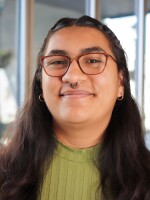Powwows are a tradition that dates back centuries. They’re a way to share and preserve Indigenous cultures among nations, and powwows have become long-awaited-for events throughout the country.
Strong drums fill the gatherings with a liveliness, only riveled by the glittering regalia that fights for the attention of spectators’ eyes. Feathers fly to the beat of the drum, and the jingle of bells cascades over the crowd as the community celebrates the opening of the sacred circle.

Every year the powwow circle welcomes new visitors and dancers. The gatherings are social, and like all social events, there are rules.
Calyn Garza came to the Honor the Heartbeat Powwow at the Expo Center in the Wisconsin State Fair Grounds — it was her first visit:
“I really had no clue what to expect. I've never experienced anything like this before, so I was just really excited to kind of see what would go on,” says Garza.
The rules are so important because there’s a spiritual meaning behind them — that’s why learning the processes can enhance the experience for all those involved.
While powwows are a common tradition, etiquette and practices may vary depending on the nation inviting the community, as they may do things differently according to their traditions.
This year, to prepare for the powwow, the Gerald L. Ignace Indian Health Center (GLIIHC) held a powwow etiquette class. It welcomed both Native and non-Native community members.
Marilyn Madosh is a member of the Menominee Nation and the intergenerational programs coordinator. She says this class is necessary to preserve powwow tradition.
“Sometimes we just go through like our cultural, like the powwow ceremonies through all different things and assuming that our own people know what it is and then there’s — we’re getting older, right. A lot of the elders have left us already, so Danny is the next one in line, and I saw him coming out as well and explaining what in his experiences of what etiquette is to give the community that. So they can also understand etiquette just in general,” says Madosh.
The class was led by Daniel Preston, a member of the San Carlos Apache Tribe and the health center’s cultural and spiritual advisor, who is a powwow dancer himself. He says he wanted to lead this so the next generation of dancers, drummers and spectators could avoid unnecessary mistakes.
“I experience some of that stuff firsthand, some of the stuff that happens inside the powwow circuit,” says Preston.
Preston covered topics such as grand entry.
It’s the opening ceremony of the powwow, where spectators should stand if they’re able, remove all headwear, and should refrain from speaking to give those in the circle their attention and respect.

For dancers, Preston stressed the importance of keeping all regalia secure. Even a single eagle feather dropping could stop a whole powwow.
“Anything where an eagle feather drops and touches the ground means that a warrior is falling, and they have a whole — they stopped the whole powwow just so they could have a ceremony just for that one eagle feather,” says Preston.
He also spoke about the types of songs that are played, the position of head dancers, the direction of the powwow circle, and more.
At the powwow, families and community organizations gathered to spend a day together filled with culture and learn about mental health and wellness resources accessible to them.
Calyn Garza — who didn’t know what to expect at her first recent powwow — had this reflection:
“It's been really fascinating so far, but I didn't really have any preconceived ideas of what would happen because I really wasn't sure, so I was just going to kind of soak in whatever happened here,” says Garza.
Katie Platt was with Garza. She said she had no idea about powwow etiquette but kept respect in mind.
“Like Katie said, just kind of like stand, observe, appreciate the culture, clap, kind of listen to the guy on the microphone, like stand when you stand, sit when you're able to sit, kind of just like respecting what is expected of us,” says Platt.
The powwow etiquette class was held to make sure those attending powwows this season had a reliable place to learn before attending. Here’s Marilyn Madosh of the Menominee Nation:
“They may or may not be taught at the powwow. They're just going to go through life assuming things, which is better to learn right from at least the Native people, the Native perspective,” she says.
While powwows are exciting community events, it’s still a place of sacred meaning to Native communities in Wisconsin and across the country. Preserving the tradition means also passing down the rules and expectations of the powwow circle.





